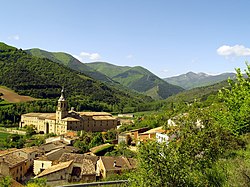San Millán de la Cogolla (Spanish pronunciation: [sam miˈʎan de la koˈɣoʎa]) is a sparsely populated municipality in La Rioja, (Spain). The village is famous for its twin monasteries, Yuso and Suso (Monasterio de San Millán de Yuso and Monasterio de San Millán de Suso), which were declared a World Heritage Site in 1997. There were 293 inhabitants registered in 2009, the population having fallen significantly during the twentieth century.
San Millán de la Cogolla | |
|---|---|
 | |
| Coordinates: 42°10′N 2°52′W | |
| Country | |
| Autonomous community | |
| Province | La Rioja |
| Comarca | Nájera |
| Government | |
| • Mayor | María Pilar Mendoza Martínez (PSOE) |
| Area | |
| • Total | 31.19 km2 (12.04 sq mi) |
| Elevation | 728 m (2,388 ft) |
| Population (2018)[1] | |
| • Total | 222 |
| • Density | 7.1/km2 (18/sq mi) |
| Demonym | Emilianenses |
| Time zone | UTC+1 (CET) |
| • Summer (DST) | UTC+2 (CEST) |
| Postal code | 26326 |
| Website | http://www.sanmillandelacogolla.es |
Etymology and local languages
In a papal bull from 1199 where Privileges were granted to the monasteries of San Millán de la Cogolla it appears with the name Coculla, which comes from the Latin word cuculla, small hill, hilltop; this word is typically used for high sites and those of defensive nature, coming from the times of the Reconquista.[2] The other part of the name is taken from a 6th-century saint (Saint Emilianus or San Millán) who lived here.
San Millán has a claim to being the birthplace of the Spanish language.[3] This claim is based on its monasteries being the home of a medieval manuscript which contains the Glosas Emilianenses, and is reinforced by the proximity of the village to Berceo which is associated with Gonzalo de Berceo, the first Spanish poet known by name.
The area is now Spanish-speaking, but some of the local place-names are of Basque origin, and the Glosas Emilianenses, provides evidence that in medieval times Basque was spoken alongside an early form of Spanish.[4]
History
In medieval times the monastery had a large estate.[5] and benefited from being on one of the variants of the Camino de Santiago.
The monastery and the surrounding area suffered in the civil war between Peter of Castile and Henry II of Castile which involved a major confrontation nearby, the Battle of Nájera (April 1371). Those affected included the small Jewish community (aljama) of San Millán. In 1369 Henry II of Castile made an order in their favour, "the Christian men and women and the Moorish men and women" should immediately discharge all their debts to the Jews, "that the last-named might be able to pay their taxes the more promptly." On September 10, 1371, however, the king released the abbot and all the monks of San Millán from whatever debts they had contracted with the Jews since the Battle of Nájera.[6]
Politics
| Term | Mayor | Political Party |
|---|---|---|
| 1979–1983 | Santiago Lerena Alesanco | UCD |
| 1983–1987 | Santiago Lerena Alesanco | AP |
| 1987–1991 | Millán Ángel Baltanás Lorenzo | PSOE |
| 1991–1995 | Millán Ángel Baltanás Lorenzo | PSOE |
| 1995–1999 | Eladio Cañas Ureta | PR |
| 1999–2003 | Eladio Cañas Ureta | PP |
| 2003–2007 | Eladio Cañas Ureta | PP |
| 2007–2011 | María Pilar Mendoza Martínez | PSOE |
| 2011–2015 | María Pilar Mendoza Martínez | PSOE |
| 2015–2019 | Raquel Fernández Tejerina | PP |
| 2019–2023 | n/d | n/d |
| 2023– | n/d | n/d |
Notable people
- Juan de San Millán
- Antonio Segura
- María de la O Lejárraga
- Leandro Nieto Bolandier
- Joaquín Peña
- Tarsicio Lejárraga
See also
References
External links
Wikiwand in your browser!
Seamless Wikipedia browsing. On steroids.
Every time you click a link to Wikipedia, Wiktionary or Wikiquote in your browser's search results, it will show the modern Wikiwand interface.
Wikiwand extension is a five stars, simple, with minimum permission required to keep your browsing private, safe and transparent.




